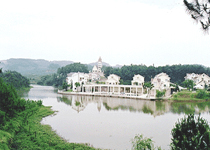Attration Category
Chongqing Weather

Qiaoping Mountain is located in the Lujiao Town of Ba'nan District of Chongqing. It is a low mountain with an area of more than 25 square kilometers and an average elevation of 650 meters. The highest peak of Qiaoping Mountain is 750 meters high Ma'an Mountain. Looking upward from the foot of the mountain, you can enjoy the view of Qiaoping Mountain plugging into the sky in the basin. Looking down from the top of Qiaoping Mountain, you can see another view: mountains are distributed around with large tracts of forests dotted with flowers; many lakes, springs, terraced fields, orchards are also ornamented in the mountains.
Attractions of Qiaoping Mountain
The scenic area of Qiaoping Mountain is famous for its ancient villages, ancient temples as well as ancient tombs.
Ancient Villages of Qiaoping Mountain
The ancient villages of Qiaoping Mountain occupy a total area of 27 square kilometers. They were built according to the stretching trends of the mountains with steep cliffs erecting straight around, forming a situation that mountains are villages and villages are mountains. So the ancient villages are naturally solid and firm. In Guangxu years of Qing Dynasty, the Qiaoping Village was completed totally with altogether 48 gates. These ancient villages have experienced many years of wars and 24 gates are still well preserved.
Ancient Temples of Qiaoping Mountain
After the Song Dynasty, Qiaoping Mountain became the holy land for Buddhism with 48 temples. Tiancheng Temple, Chaodeng Temple and Baiyun Temple were all built in the northern Song Dynasty. Many historical relics are still kept in good condition.
In Wanli the 25th year of Ming Dynasty (1597), the then emperor took refuge in Chongqing and once stayed in the Baiyun Temple.
Ancient Tombs of Qiaoping Mountains
There are many ancient tombs in the Qiaoping Mountain. The so-called Manzi Cave is the tomb of Han Dynasty. More tombs here were built in Ming and Qing Dynasty. The grave of Bamanzi general and the grand tomb of Liu Chunjun-an official of Ming Dynasty are both kept in good conditions.


